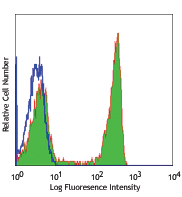- Regulatory Status
- RUO
- Other Names
- Neutralizing antibodies against Spike S1 protein of SARS-CoV-2 Variants: Alpha (B.1.1.7), Beta (B.1.351), Gamma (P.1), Delta(B.1.617.2), Omicron (B.1.1.529) and Wild Type S1 protein
- Ave. Rating
- Submit a Review
- Product Citations
- publications
SARS-CoV-2 continuously evolves as changes in the genetic code occur during replication of the genome. SARS-CoV-2 variants have been emerging and circulating around the world since the beginning of the COVID-19 pandemic, e.g. Alpha (B.1.1.7, first identified in United Kingdom), Beta (B.1.351, first identified in South Africa), Gamma (P.1, first identified in Brazil), Delta (B.1.617.2, first identified in India), etc. The Omicron variant (B.1.1.529) emerged in November 2021 in South Africa and it quickly spread throughout the world.
LEGENDplex™ SARS-CoV-2 Variants Neut. Ab Panel (6-plex) is a multiplex beads-based competitive assay. Capture beads are pre-coated with six SARS-CoV-2 Spike protein Variants (Alpha, Beta, Gamma, Delta, Omicron, and Wild type S1 protein) conjugated onto fluorochrome-coded beads. Biotinylated ACE2 protein serving as the detection reagent will be added to all wells after adding the beads. Standard (anti-SARS-CoV-2 S Protein S1 antibody) or samples and the detection reagent will compete to bind to the capture beads, producing a competitive assay. Streptavidin-phycoerythrin (SA-PE) is subsequently added, which will bind to the biotinylated detection reagent, providing fluorescent signal intensities in proportion to the amount of bound analytes. The concentration of a neutralization antibody is determined using a standard curve generated in the same assay. Due to the nature of the assay, the standard curve will have the highest signal at the lowest standard neutralization antibody concentration and the signal will decrease as the standard neutralization antibody concentration increases.
Kit Contents
- Kit Contents
-
- Setup Beads: PE Beads
- Setup Beads: Raw Beads
- SARS-CoV-2 Variants Neut. Ab Pre-mix Beads (6-plex)
- SARS-CoV-2 Variants Neut. Ab Detection
- SARS-CoV-2 Variants Neut. Ab Standard
- LEGENDplex™ SA-PE
- LEGENDplex™ Assay Buffer
- LEGENDplex™ Wash Buffer, 20X
- Plate Sealers
- Filter Plate or V-bottom Plate
Product Details
- Verified Reactivity
- Human
- Application
-
Multiplex
Learn more about LEGENDplex™ at biolegend.com/legendplex
Download the LEGENDplex™ software here. - Materials Not Included
-
- Flow Cytometer
- Pipettes and Tips
- Reagent Reservoirs for Multichannel Pipettes
- Polypropylene Microfuge Tubes
- Vortex Mixer
- Sonicator
- Aluminum Foil
- Absorbent Pads or Paper Towels
- Plate Shaker
- Tabletop Centrifuges
- A Vacuum Filtration Unit and a Vacuum Source (if using filter plates)
- Centrifuge with a swinging bucket adaptor for microtiter plates (if using V-bottom plates)
- 1.1 mL polypropylene micro FACS tubes, in 96-tube rack
- Manual
Related Pages & Pathways
Pages
Related FAQs
- If I don't have a vacuum, how do I remove the liquid from my plate?
-
If you do not have a vacuum, the assay should be run in a V-bottom plate. After centrifugation using a swinging-bucket rotor with a plate adaptor, you can remove the liquid by flicking the plate quickly, dumping the contents into a sink, and patting it dry carefully on a stack of clean paper towels without losing the beads. Alternatively, you can remove the liquid by using a pipette.
- Should I perform the assay with the filter plates or with V-bottom plates?
-
Filter plates or V-bottom plates have been included in some kits for your convenience. A vacuum filtration unit is required to work with the filter plates. However, if you don’t have access to a vacuum manifold or if you prefer, then you can use the V-bottom plates and follow the recommended assay protocols for the type of plates you choose. All plates should be made from low binding polypropylene. Polystyrene ELISA or cell culture plates should not be used.
- After I finish the staining process, how long can I wait before reading my LEGENDplex™ samples?
-
The samples can be kept overnight at 4°C while being protected from exposure to light and be read the next day. There may be a decrease in signal, but overall, the assay results should not be affected. Storing the samples for extended periods of time is not recommended, as it could lead to further reductions in signal.
- What is the shelf life of LEGENDplex™ kits?
-
LEGENDplex™ kits are guaranteed for 6 months from the date of receipt, but may have a shelf life of up to 2 years from the date of manufacture.
- Is special software required for data analysis?
-
Typically flow cytometers generate output files in FCS format (e.g. FCS 2.0, 3.0, or 3.1) and in some cases in list mode file format (LMD). Other software may be available to analyze FCS files. Data generated using LEGENDplex™ kits can be analyzed using the freely available LEGENDplex™ data analysis software. Please check our website for the most updated versions of the software.
 Login / Register
Login / Register 











Follow Us